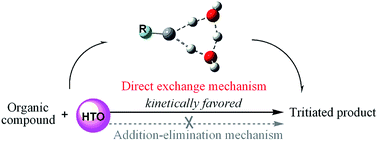Isotope exchange reaction in tritium-contaminated vacuum pump oil: mechanism and HTO effect†
Abstract
As radioactive wastes, contaminated vacuum pump oils from tritium-processing facilities are challenging to dispose of. In this study, we investigated the mechanism of the tritium–hydrogen (T–H) exchange reaction between the tritiated water (HTO) and many typical organic molecules in vacuum pump oil using a density functional theory (DFT) method. The T–H exchange reaction could proceed with two mechanisms, the direct T–H exchange mechanism and the addition–elimination T–H exchange mechanism. The calculation indicates that the direct T–H exchange mechanism is kinetically favored. The HTO molecule is not only a reactant, but also acts as the proton shuttle in the transition state. The number of HTO molecules participating in the reaction is determined by the formation of the stable six-membered ring proton migration transition state. The T–H exchange reaction is selective, and molecules with COOH and OH groups preferentially undergo hydrogen exchange with HTO. In the case of multiple possible products, the calculations correctly predicted the predominant product. The results here will provide guidance for improving the associated decontamination process and reducing the environmental impact.


 Please wait while we load your content...
Please wait while we load your content...